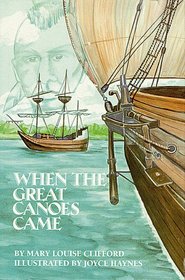Reviewed by Grandma Bev for TeensReadToo.com
This book reveals history through the eyes of the Native Americans as they lived it. History usually details the settling of Jamestown and the Chesapeake Bay area from the viewpoint of the English colonists, and we can only guess at what the Indians experienced. In WHEN THE GREAT CANOES CAME, Clifford shows us their hardships and emotions through the storytelling of the female chief, Cockacoeske, successor to Powhatan, as she relates the tribal history to the boy, Lost Owl, and his friends. The boys are at the age that their ancestors had their huskenaw, or coming of age ordeals and rituals.
While the native language and names are challenging to pronounce and the tribal relations require some effort and concentration to keep straight, the story about this exciting chapter in our history is thought-provoking and compelling.
Cockacoeske describes the days before and after the arrival of the European settlers. The great chiefs, Powhatan and Opechancanough, deal with the invaders to the best of their ability through the harsh weather and the atrocities committed by the English. The story is told through episodes of the Pamunkey everyday life, interspersed with storytelling sessions.
Mary Louise Clifford's extensive research is evident in this footnoted account of 17th-century America. An epilogue tells of the fate of the tribes after the Jamestown Island settlement in 1607. Ten illustrations, a bibliography, map, genealogical chart, and chronology add to the reading experience. This book would be an outstanding extra accompaniment for early American history studies in elementary school or home school to help put that era in perspective.
Meet Powhatan, Pocahontas, Captain John Smith, John Rolfe, and other historical legends in a whole new perspective.
This book reveals history through the eyes of the Native Americans as they lived it. History usually details the settling of Jamestown and the Chesapeake Bay area from the viewpoint of the English colonists, and we can only guess at what the Indians experienced. In WHEN THE GREAT CANOES CAME, Clifford shows us their hardships and emotions through the storytelling of the female chief, Cockacoeske, successor to Powhatan, as she relates the tribal history to the boy, Lost Owl, and his friends. The boys are at the age that their ancestors had their huskenaw, or coming of age ordeals and rituals.
While the native language and names are challenging to pronounce and the tribal relations require some effort and concentration to keep straight, the story about this exciting chapter in our history is thought-provoking and compelling.
Cockacoeske describes the days before and after the arrival of the European settlers. The great chiefs, Powhatan and Opechancanough, deal with the invaders to the best of their ability through the harsh weather and the atrocities committed by the English. The story is told through episodes of the Pamunkey everyday life, interspersed with storytelling sessions.
Mary Louise Clifford's extensive research is evident in this footnoted account of 17th-century America. An epilogue tells of the fate of the tribes after the Jamestown Island settlement in 1607. Ten illustrations, a bibliography, map, genealogical chart, and chronology add to the reading experience. This book would be an outstanding extra accompaniment for early American history studies in elementary school or home school to help put that era in perspective.
Meet Powhatan, Pocahontas, Captain John Smith, John Rolfe, and other historical legends in a whole new perspective.




